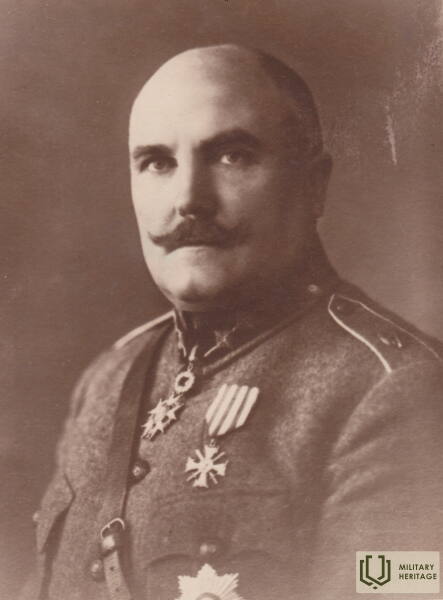Mārtiņš Peniķis (1874- 1964) Latvijos kariuomenės vadas, generolas
I WW1, I Nepriklausomybės karai, II Antrasis pasaulinis karas, IV Sovietų okupacija
Mārtiņš Peniķis gimė 1874 m. lapkričio 6 d. Kuldygos rajone. Ķoninių kaime, senovės kuršių laisvininkų šeimoje (Ķoniņi). Mokėsi Kuldygos ministerijos mokykloje ir toliau mokėsi.
1896 m. įstojo į Rusijos armiją ir tarnavo 133-ajame Simferopolis pėstininkų pulke. 1900 metais įstojo į Chuguyev Junker mokyklą. 1902 m. buvo pakeltas į pulkininkus leitenantus ir paskirtas į 121-ąjį pėstininkų pulką Charkove. Dalyvavo Rusijos ir Japonijos kare.
1913 metais buvo priimtas į Nikolajaus karo akademiją. Pirmojo pasaulinio karo pradžioje grįžo į pulką. Būdamas kuopos vadu, dalyvavo mūšiuose Galisijos fronte ir buvo sunkiai sužeistas. Pasveikęs kovėsi keliose kautynėse prie Krokuvos. 1915 m. dalyvavo vasaros mūšiuose prieš Mackenzie kariuomenę, vėliau – užnugario mūšiuose nuo Brest-Litovsko iki Baranovičių. 1916 m. Vasarą jis kovėsi bataliono vadu prie Šaro upės. Pakelti. pulkininku, skaičiuojant nuo 1915 m. lapkričio 26 d.
1916 11 16 paskirtas 2-ojo Rygos latvių šaulių pulko vadu. Dalyvavo kalėdinėse kovose, kovojo prie Ložmetējkalno. Apdovanojimas. su Jurgio kardu. 1917 m. rugsėjį gynė pozicijas Maza Juglos upės pakrantėje. Iš tarnybos pasitraukė 1918 m. pradžioje ir liko Vidžemėje. Jį sugavo vokiečiai ir grįžo 1918 m. lapkričio pabaigoje.
Įkūrus Latvijos valstybę, savo noru įstojo į jos ginkluotąsias pajėgas ir 1918 12 08 paskirtas Kuršo karo apygardos viršininku, vėliau Karinių planų rengimo ir štabo organizavimo komisijos nariu. Nuo 1919 m. birželio mėn. buvo Liepojos apygardos latvių kariuomenės vadas divizijos vado teisėmis. Bermonto puolimo pradžioje buvo paskirtas 2-osios Vidžemės divizijos vadu ir Pietų fronto vadu. Mūšiuose nuo Rygos iki Lietuvos sienos vadovavo pavaldiems daliniams, vėliau dalyvavo mūšiuose prieš bolševikus Latgaloje.
Jis vienas pirmųjų buvo apdovanotas Lāčplės karo III laipsnio ordinu, paskirtas LKO tarybos nariu, tarybos pirmininku iki Konstitucinio susirinkimo ordino įstatų priėmimo, vėliau – Tarybos pirmininko nariu. 1927 m. apdovanotas Raudonojo Kryžiaus II laipsnio ordinu.
1920 07 30 paskirtas Latvijos kariuomenės Generalinio štabo viršininku. Pakeltas į generolus, įsigaliojo 1920 m. vasario 5 d. 1921-1924 m. Karinis inspektorius. 1928 metais buvo paskirtas kariuomenės vadu. Šias pareigas ėjo iki 1934 m., kol išėjo į pensiją.
M. Peniķis studijavo karo istoriją ir skaitė paskaitas Aukštojoje karo mokykloje; daugelio knygų autorius. Snėpelės valsčiuje skirtas Mazsalijos malūnas. Apdovanotas daugeliu Latvijos, carinės Rusijos ir užsienio ordinais.
1943 m. jis atsisakė siūlomų Latvijos legiono generalinio inspektoriaus pareigų. 1944 m. jis su šeima pabėgo į Vokietiją. Jis atsidūrė sovietų okupacinėje zonoje, iš kur grįžo į Latviją. Gyveno Rygoje, vertėsi karo istorijos tyrinėjimais. Mārtiņš Peniķis mirė 1964 metų vasario 18 dieną Rygoje ir buvo palaidotas Miško kapinėse.
Daugiau informacijos šaltinių
Erikas Jacobsonas. Martinas Penikis. – Nacionalinė enciklopedija. https://enciklopedija.lv/skirklis/29981-M%C4%81rti%C5%86%C5%A1-Peni%C4%B7is
Karo ordino kavalieriaus Mārtiņa Peniķo Lāčplėčio biografija. https://web.archive.org/web/20150115071605/http://www.lkok.com/detail1.asp?ID=2121








